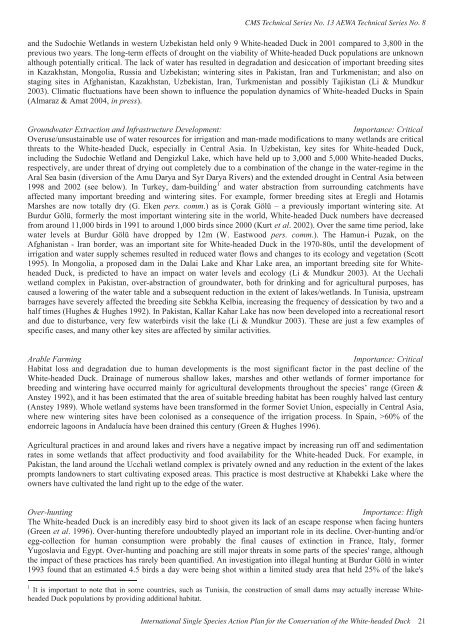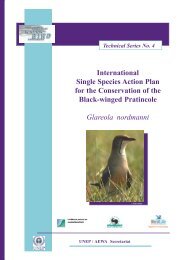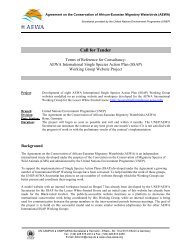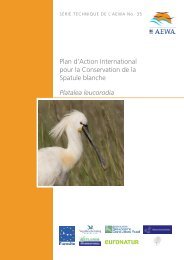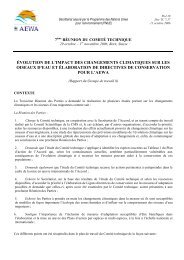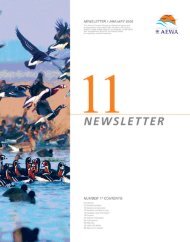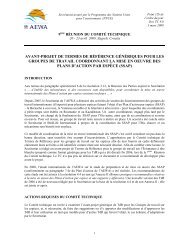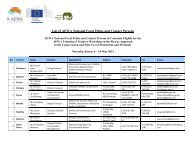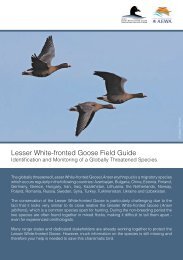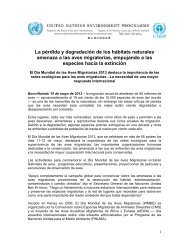International Single Species Action Plan for the Conservation - AEWA
International Single Species Action Plan for the Conservation - AEWA
International Single Species Action Plan for the Conservation - AEWA
You also want an ePaper? Increase the reach of your titles
YUMPU automatically turns print PDFs into web optimized ePapers that Google loves.
CMS Technical Series No. 13 <strong>AEWA</strong> Technical Series No. 8<br />
and <strong>the</strong> Sudochie Wetlands in western Uzbekistan held only 9 White-headed Duck in 2001 compared to 3,800 in <strong>the</strong><br />
previous two years. The long-term effects of drought on <strong>the</strong> viability of White-headed Duck populations are unknown<br />
although potentially critical. The lack of water has resulted in degradation and desiccation of important breeding sites<br />
in Kazakhstan, Mongolia, Russia and Uzbekistan; wintering sites in Pakistan, Iran and Turkmenistan; and also on<br />
staging sites in Afghanistan, Kazakhstan, Uzbekistan, Iran, Turkmenistan and possibly Tajikistan (Li & Mundkur<br />
2003). Climatic fluctuations have been shown to influence <strong>the</strong> population dynamics of White-headed Ducks in Spain<br />
(Almaraz & Amat 2004, in press).<br />
Groundwater Extraction and Infrastructure Development: Importance: Critical<br />
Overuse/unsustainable use of water resources <strong>for</strong> irrigation and man-made modifications to many wetlands are critical<br />
threats to <strong>the</strong> White-headed Duck, especially in Central Asia. In Uzbekistan, key sites <strong>for</strong> White-headed Duck,<br />
including <strong>the</strong> Sudochie Wetland and Dengizkul Lake, which have held up to 3,000 and 5,000 White-headed Ducks,<br />
respectively, are under threat of drying out completely due to a combination of <strong>the</strong> change in <strong>the</strong> water-regime in <strong>the</strong><br />
Aral Sea basin (diversion of <strong>the</strong> Amu Darya and Syr Darya Rivers) and <strong>the</strong> extended drought in Central Asia between<br />
1998 and 2002 (see below). In Turkey, dam-building 1 and water abstraction from surrounding catchments have<br />
affected many important breeding and wintering sites. For example, <strong>for</strong>mer breeding sites at Eregli and Hotamis<br />
Marshes are now totally dry (G. Eken pers. comm.) as is Çorak Gölü – a previously important wintering site. At<br />
Burdur Gölü, <strong>for</strong>merly <strong>the</strong> most important wintering site in <strong>the</strong> world, White-headed Duck numbers have decreased<br />
from around 11,000 birds in 1991 to around 1,000 birds since 2000 (Kurt et al. 2002). Over <strong>the</strong> same time period, lake<br />
water levels at Burdur Gölü have dropped by 12m (W. Eastwood pers. comm.). The Hamun-i Puzak, on <strong>the</strong><br />
Afghanistan - Iran border, was an important site <strong>for</strong> White-headed Duck in <strong>the</strong> 1970-80s, until <strong>the</strong> development of<br />
irrigation and water supply schemes resulted in reduced water flows and changes to its ecology and vegetation (Scott<br />
1995). In Mongolia, a proposed dam in <strong>the</strong> Dalai Lake and Khar Lake area, an important breeding site <strong>for</strong> Whiteheaded<br />
Duck, is predicted to have an impact on water levels and ecology (Li & Mundkur 2003). At <strong>the</strong> Ucchali<br />
wetland complex in Pakistan, over-abstraction of groundwater, both <strong>for</strong> drinking and <strong>for</strong> agricultural purposes, has<br />
caused a lowering of <strong>the</strong> water table and a subsequent reduction in <strong>the</strong> extent of lakes/wetlands. In Tunisia, upstream<br />
barrages have severely affected <strong>the</strong> breeding site Sebkha Kelbia, increasing <strong>the</strong> frequency of dessication by two and a<br />
half times (Hughes & Hughes 1992). In Pakistan, Kallar Kahar Lake has now been developed into a recreational resort<br />
and due to disturbance, very few waterbirds visit <strong>the</strong> lake (Li & Mundkur 2003). These are just a few examples of<br />
specific cases, and many o<strong>the</strong>r key sites are affected by similar activities.<br />
Arable Farming Importance: Critical<br />
Habitat loss and degradation due to human developments is <strong>the</strong> most significant factor in <strong>the</strong> past decline of <strong>the</strong><br />
White-headed Duck. Drainage of numerous shallow lakes, marshes and o<strong>the</strong>r wetlands of <strong>for</strong>mer importance <strong>for</strong><br />
breeding and wintering have occurred mainly <strong>for</strong> agricultural developments throughout <strong>the</strong> species’ range (Green &<br />
Anstey 1992), and it has been estimated that <strong>the</strong> area of suitable breeding habitat has been roughly halved last century<br />
(Anstey 1989). Whole wetland systems have been trans<strong>for</strong>med in <strong>the</strong> <strong>for</strong>mer Soviet Union, especially in Central Asia,<br />
where new wintering sites have been colonised as a consequence of <strong>the</strong> irrigation process. In Spain, >60% of <strong>the</strong><br />
endorreic lagoons in Andalucía have been drained this century (Green & Hughes 1996).<br />
Agricultural practices in and around lakes and rivers have a negative impact by increasing run off and sedimentation<br />
rates in some wetlands that affect productivity and food availability <strong>for</strong> <strong>the</strong> White-headed Duck. For example, in<br />
Pakistan, <strong>the</strong> land around <strong>the</strong> Ucchali wetland complex is privately owned and any reduction in <strong>the</strong> extent of <strong>the</strong> lakes<br />
prompts landowners to start cultivating exposed areas. This practice is most destructive at Khabekki Lake where <strong>the</strong><br />
owners have cultivated <strong>the</strong> land right up to <strong>the</strong> edge of <strong>the</strong> water.<br />
Over-hunting Importance: High<br />
The White-headed Duck is an incredibly easy bird to shoot given its lack of an escape response when facing hunters<br />
(Green et al. 1996). Over-hunting <strong>the</strong>re<strong>for</strong>e undoubtedly played an important role in its decline. Over-hunting and/or<br />
egg-collection <strong>for</strong> human consumption were probably <strong>the</strong> final causes of extinction in France, Italy, <strong>for</strong>mer<br />
Yugoslavia and Egypt. Over-hunting and poaching are still major threats in some parts of <strong>the</strong> species' range, although<br />
<strong>the</strong> impact of <strong>the</strong>se practices has rarely been quantified. An investigation into illegal hunting at Burdur Gölü in winter<br />
1993 found that an estimated 4.5 birds a day were being shot within a limited study area that held 25% of <strong>the</strong> lake's<br />
1 It is important to note that in some countries, such as Tunisia, <strong>the</strong> construction of small dams may actually increase Whiteheaded<br />
Duck populations by providing additional habitat.<br />
<strong>International</strong> <strong>Single</strong> <strong>Species</strong> <strong>Action</strong> <strong>Plan</strong> <strong>for</strong> <strong>the</strong> <strong>Conservation</strong> of <strong>the</strong> White-headed Duck 21


